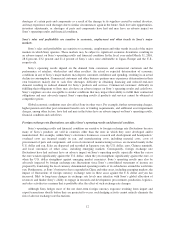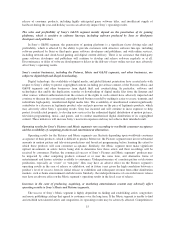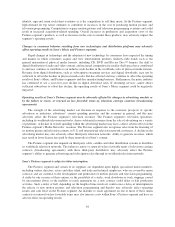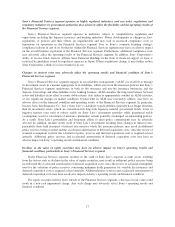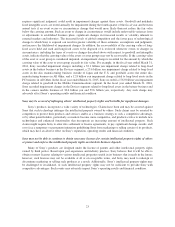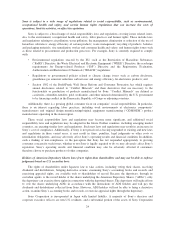Sony 2015 Annual Report Download - page 22
Download and view the complete annual report
Please find page 22 of the 2015 Sony annual report below. You can navigate through the pages in the report by either clicking on the pages listed below, or by using the keyword search tool below to find specific information within the annual report.Further losses in jurisdictions where Sony has established valuation allowances against deferred tax assets,
the inability of Sony to fully utilize its deferred tax assets, exposure to additional tax liabilities or changes in
Sony’s tax rates could adversely affect net income (loss) attributable to Sony Corporation’s stockholders and
Sony’s financial condition.
Sony is subject to income taxes in Japan and numerous other jurisdictions, and in the ordinary course of
Sony’s business there are many situations where the ultimate tax determination can be uncertain, sometimes for
an extended period. The calculation of Sony’s tax provision and the carrying value of tax assets and liabilities
requires significant judgment and the use of estimates, including estimates of future taxable income.
Deferred tax assets are evaluated on a jurisdiction by jurisdiction basis. In certain jurisdictions, Sony has
established valuation allowances against deferred tax assets, including net operating loss carryforwards, where it
has concluded that the deferred tax assets are not more likely than not to be realized. As of March 31, 2016, Sony
had valuation allowances principally in the following jurisdictions: (1) Sony Corporation and its national filing
group in Japan, as well as for local taxes in a number of Japanese subsidiaries; (2) Sony Americas Holding Inc.
and its consolidated tax filing group in the U.S.; (3) Sony Mobile Communications AB in Sweden; and (4) Sony
Europe Limited in the U.K. In jurisdictions where valuation allowances have been established, no tax benefit will
be recorded against any continuing losses and as a result, net income (loss) attributable to Sony Corporation’s
stockholders and Sony’s financial condition could be adversely affected. Additionally, deferred tax assets could
expire unused or otherwise not be realizable if Sony is unable to implement tax planning strategies or generate
sufficient taxable income in the appropriate jurisdiction in the future (from operations and/or tax planning
strategies) to utilize them, or if Sony enters into transactions that limit its legal ability to use them. As a result,
Sony may lose any associated cash tax reduction available in future periods. If it becomes more likely than not
that any of Sony’s remaining deferred tax assets without valuation allowances will expire unused and are not
available to offset future taxable income, or otherwise will not be realizable, Sony will have to recognize an
additional valuation allowance, increasing income tax expense. Net income (loss) attributable to Sony
Corporation’s stockholders and Sony’s financial condition could be adversely affected when the deferred tax
assets expire unused or in periods in which an additional valuation allowance is recorded.
A key factor in the evaluation of the deferred tax assets and the valuation allowance is the determination of
the uncertain tax positions related to the adjustments for Sony’s intercompany transfer pricing. Sony is subject to
income taxes in Japan and numerous other jurisdictions, and in the ordinary course of Sony’s business there are
many transactions, including intercompany charges, where the ultimate tax determination is uncertain. Sony is
subject to the continuous examination of its income tax returns by tax authorities and, as a result, Sony regularly
assesses the likelihood of adverse outcomes resulting from these examinations to determine the adequacy of its
provision for income taxes. Significant judgment is required in making these assessments and, as additional
evidence becomes available in subsequent periods, the ultimate outcomes for Sony’s uncertain tax positions and,
accordingly, its valuation allowance assessments may potentially have an adverse impact on net income (loss)
attributable to Sony Corporation’s stockholders and Sony’s financial condition.
In some jurisdictions, the use of net operating loss carryforwards to reduce taxable income in a subsequent
period is limited to a fixed percentage of taxable income. Thus, it is possible that even with significant net
operating loss carryforwards, Sony could record and pay taxes in a jurisdiction where it has taxable income but
still has significant net operating loss carryforwards available.
In addition to the above, Sony’s future effective tax rates may be unfavorably affected by changes in both
the statutory rates and the mix of earnings in countries with differing statutory rates or by other factors such as
changes in tax laws and regulations or their interpretation, including limitations or restrictions on the use of net
operating loss and income tax credit carryforwards.
Sony could incur asset impairment charges for goodwill, intangible assets or other long-lived assets.
Sony has a significant amount of goodwill, intangible assets and other long-lived assets, including
production facilities and equipment in its electronics businesses. A decline in financial performance, market
capitalization or changes in estimates and assumptions used in the impairment analysis, which in many cases
22


